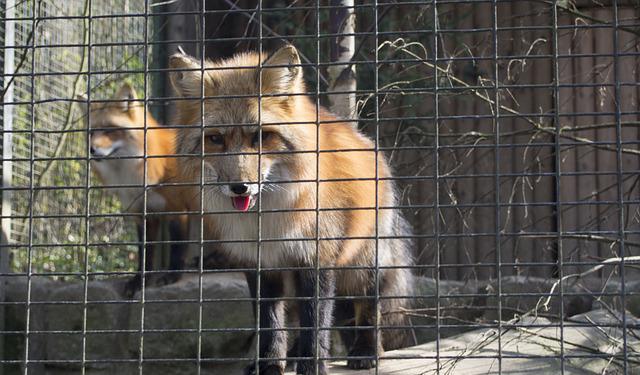Looking for a Cage for Pet Fox? Here Are the Things to Consider
If you have recently adopted a fox or are planning on getting a pet fox, there are certain things one should consider, housing them being one of them. Foxes are members of the canine family, they are clever, amusing, and generally a quite captivating pet; although, their temperament bears almost no resemblance to pet dogs. They are wild animals, used to living in wide-open spaces, and thus if you want to keep one as a pet, there are some specific things like their behavioral traits, their specific needs, and requirements one must learn about to become a good owner.

Enclosure for a pet fox
A fox left unsupervised in an indoor space like an apartment is a danger to itself as well as its owner, being of carefree wild nature they are likely to jump on furniture, run about the place and wreak havoc in any space and most importantly they can end up injuring themselves, falling from a piece of high furniture, or crashing through a glass door. Therefore, it is a better choice to have an enclosure for your fox where it can stay when unsupervised.
Size and general plan of the cage
Depending on whether you plan on housing your fox indoors or outdoors, the requirements of their enclosure differ slightly.
1- For an outdoor fox enclosure, you need to make sure that the fox can’t dig its way out through the soil, since foxes are efficient diggers as they are used to digging burrows in the wild.
2- Their cage needs to be at least 60 sq. ft. Foxes require a large area and confining them to a small space for a long time can make them moody and aggressive.
3- For an indoor fox cage, you should try adding multiple floors in their enclosure to better keep the fox occupied and entertained.
4- The chain used in their cage’s wall should be thick enough for it to prevent being chewed by the fox and leave an opening in their enclosure for those escape artists to flee.
5- The top of their cage should also be covered with chain links, as foxes learn to climb their enclosure walls quite easily.
Enrichment stuff in the cage
Foxes require enrichment stuff in their cage, like hanging toys, a sandbox is also a good option, it can be placed in a corner of their enclosure, multiple shelves and levels in their cage connected with ramps, and even cat stuff like climbing trees, squeaking toys are good.
A fox will also require a specific sleeping area in their cage, you can place a doghouse there like the ones used for large dogs, or even spread substrate such as straw. In either case, their sleeping area would require cleaning every other day, if not every day, if you want your pet’s space to be odor-free.
Their cage will also need to be equipped with food and water vessels as well as a litter box if you are planning on litter training your fox.
Food and water bowl area in the cage
Foxes are omnivorous like humans; they consume both meat and plants. Although they do require a high protein diet with lots of water.
Adult foxes mark their territory and leftover food with urine and feces, so it is recommended that you remove any of their leftover food and change their water bowl daily to prevent their cage from becoming smelly in case they do start marking their leftovers.
You can also try to combat their nature of marking their food, by having their cage made in a way that only their heads can reach the water and food bowl.
Other things to consider when getting a cage
1. For an outdoor enclosure, or even an indoor enclosure, if you live in a hot place like Australia where the temperature in summer becomes unbearably hot, you need to provide a shaded area for your fox or an air-conditioned room for them, as they need protection from extreme heat.
2. For an outdoor enclosure, there should also be an area where the fox can take shelter while it’s raining.
3. Foxes aren’t exactly very social animals; thus, if you are thinking of adopting multiple foxes, you should plan on having separate enclosures for them, as in one cage, the chances of the foxes confronting each other and fighting over resources are high.
4. When buying a cage, look for the ones that provide numerous enrichment stuff for your fox, because if your fox is bored in its cage it’s going to be extremely destructive when you let it out.
In short –
When buying a cage for your fox or making a designated space for them, like a room, always remember that your pet fox is going to be spending a lot of time in that cage. It needs a proper place to roam around in the cage and entertain itself with the enrichment stuff provided, to be happy and thrive in its environment or it may end up agitated and miserable.
A fox after reaching sexual maturity, won’t be happy if it just stays indoors, as it is a very energetic animal and will need space to run about. If kept in a cage without letting your pet fox out for short intervals, it might start displaying territorial aggression, that is why you should spend time with it, playing or taking it outside on a walk, only if it’s properly leash trained.
FAQs
Can foxes be litter trained?
Foxes can be litter trained, although it’s different from litter training a cat or dog, as foxes only learn from positive reinforcement. With proper dedication and patience, they can be litter trained but they will still mark their territory.
Can foxes be leash trained?
You can leash train a fox successfully, only if you start when it is relatively young as adult foxes will be very hard, almost impossible to leash train.


